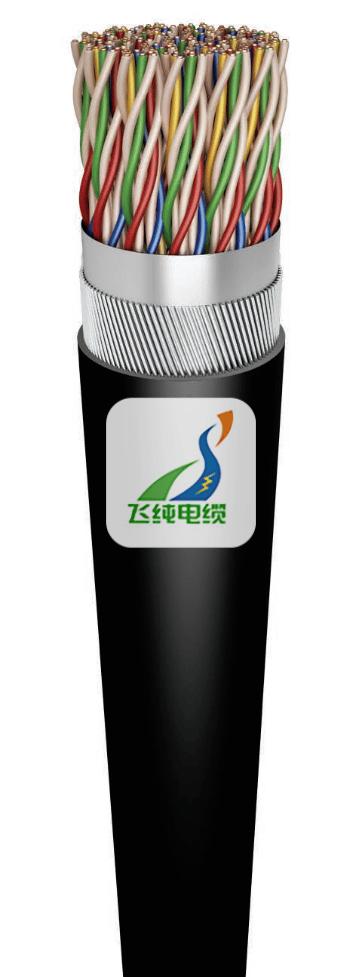Type YUTKGXFoyn & YUTKGXFtyn & YUTKGXFtlyn Shielded, Sealed, Mining telecommunications cables for mines
Inner PVC coating - polwinit
Coating color Black (RAL 9005)
Damp-proof seal Swelling tape
Reinforcement
Foy - steel wires and steel tape
Fty - steel tape
Ftl - painted steel tape
Damp-proof seal Swelling tape
Outer coating Flame retardant PVC
Coating color Black (RAL 9005)


These cables are high-performance, shielded, and sealed telecommunications cables specifically designed for mining applications.
They are engineered to provide reliable data and signaling connections in the harsh and damp underground conditions found in mines. Compliant with strict industry standards (ZN 86/MH-80iMP-13-K12098 and TT1-6549), these cables offer robust electrical performance along with excellent mechanical and environmental protection.
Construction and Materials
Core Components
Conductors:
Each cable contains a single copper conductor with a diameter of 0.8 mm, insulated with high-quality polyethylene (PE). Conductor pairs are pre-identified with color coding (e.g., red, blue, green, yellow for primary pairs and natural colors for additional pairs) to facilitate easy wiring and troubleshooting in complex mining telecommunication systems.
Inner Layers
Inner Coating:
The inner layer is made of PVC (polwinit) and is colored black (RAL 9005). This coating not only provides insulation but also contributes to the cable’s mechanical strength.
Damp-Proof Seal:
A swelling (expanding) tape is applied over the inner coating to create a damp-proof seal. This is crucial for preventing moisture ingress in underground environments.
Reinforcement
Three reinforcement types are offered to enhance mechanical durability:
Foy: Reinforced with a combination of steel wires and steel tape.
Fty: Reinforced solely with steel tape.
Ftl: Reinforced with painted steel tape for additional corrosion resistance and aesthetic consistency.
An additional layer of swelling tape is applied after reinforcement to further ensure moisture protection.
Outer Coating
Casing:
The cable’s outer jacket is made of flame-retardant, uniplaned PVC, also in black (RAL 9005). This final layer provides robust environmental protection, ensuring that the cable is both flame-resistant and durable against mechanical abrasion.
Electrical and Mechanical Characteristics
Loop Resistance:
The maximum resistance of a pair is 73.6 Ω/km, ensuring minimal signal loss over long distances.Insulation Resistance:
With a minimum insulation resistance of 5000 MΩ×km, the cable guarantees stable and safe operation.Effective Capacitance:
The effective capacitance is rated at 60 µF/km (at 800 Hz), which is essential for high-quality signal transmission.Bending Radius:
The minimum bending radius is 15 times the external cable diameter (15D), allowing flexible installations without risking damage.Temperature Range:
Operating Temperature: –5°C to +50°C.
Installation Temperature: –15°C to +60°C.
These ranges ensure that the cable can function reliably in the variable conditions typical of underground mines.
Variants and Dimensional Specifications
The cables are available in various configurations based on the number of communication pairs, such as 5, 10, 16, 24, 33, 56, 60, 100, and 200 pairs. The specific construction details vary for the different variants:
For YUTKGXFoyn:
Inner Coating Thickness: Approximately 1.4 ±0.1 mm.
Outer Coating Thickness: Approximately 1.5 ±0.2 mm.
Reinforcement: Utilizes steel wires and steel tape.
Maximum External Diameter: Ranges from 20.0 mm (for a 5-pair cable) up to 68.0 mm (for a 200-pair cable).
For YUTKGXFtyn & YUTKGXFtlyn:
Inner Coating Thickness: Approximately 1.4 ±0.1 mm.
Outer Coating Thickness: Varies from 1.6 ±0.2 mm up to 2.8 ±0.2 mm depending on the pair configuration.
Reinforcement: Utilizes either steel tape or painted steel tape.
Steel Wire Diameter in Reinforcement: Typically 0.3 mm for lower pair counts, increasing to 0.5 mm for higher pair counts.
Maximum External Diameter: Ranges from 18.0 mm (for a 5-pair cable) up to 59.0 mm (for a 200-pair cable).
Applications
These shielded, sealed mining telecommunications cables are ideal for:
Telecommunications Installations:
Providing robust data and voice transmission in mining tunnels and shafts.Signaling Systems:
Ensuring reliable signaling for mine safety systems and operational communications.Mining Machinery:
Integrating into the control and communication systems of mining equipment to maintain continuous, interference-free operation in challenging underground conditions.

Frequently Asked Questions (FAQ)
Q: What is the primary purpose of these cables?
A: They are designed to provide reliable telecommunications and signaling in underground mining environments.
Q: In what types of environments are these cables used?
A: They are engineered for harsh, damp underground mines, including tunnels, shafts, and mining machinery installations.
Q: What is the core conductor material?
A: The cables use a 0.8 mm diameter copper conductor insulated with high-quality polyethylene (PE).
Q: What is the material and color of the inner coating?
A: The inner coating is made of PVC (polwinit) and is black (RAL 9005).
Q: How are these cables protected against moisture?
A: A swelling (expanding) tape is applied as a damp-proof seal to prevent moisture ingress.
Q: What reinforcement options are available for these cables?
A: There are three types:Foy: Reinforced with steel wires and steel tape.
Fty: Reinforced with steel tape.
Ftl: Reinforced with painted steel tape.
Q: What is the purpose of the reinforcement layer?
A: It enhances the mechanical strength and durability of the cable in rugged mining environments.
Q: What additional damp-proofing is provided?
A: A second layer of swelling tape is applied after the reinforcement to ensure a complete moisture seal.
Q: What material is used for the outer jacket?
A: The outer jacket is made of flame-retardant PVC, also in black (RAL 9005).
Q: How does the flame-retardant outer jacket benefit mining applications?
A: It prevents the spread of fire, which is crucial in explosive and high-risk underground conditions.
Q: What is the maximum loop resistance specified for these cables?
A: The maximum loop resistance is 73.6 Ω/km, which minimizes signal loss over long distances.
Q: What is the minimum insulation resistance of the cables?
A: The insulation resistance is at least 5000 MΩ×km, ensuring safe operation.
Q: What is the effective capacitance of these cables?
A: The effective capacitance is 60 µF/km at 800 Hz, important for maintaining signal integrity.
Q: What is the minimum bending radius for these cables?
A: The cables must not be bent below 15 times their external diameter (15D) to prevent damage.
Q: What is the operating temperature range of these cables?
A: They operate reliably from –5°C to +50°C.
Q: What is the installation temperature range for these cables?
A: They can be installed in temperatures ranging from –15°C to +60°C.
Q: Which telecommunications applications are these cables used for?
A: They support voice, data, and signaling communications in mining telecommunication systems.
Q: How many pair configurations are available?
A: The cables come in various pair counts such as 5, 10, 16, 24, 33, 56, 60, 100, and 200 pairs to suit different system needs.
Q: How are conductor pairs identified?
A: Pairs are pre-identified by color coding (e.g., red, blue, green, yellow for primary pairs) for easy wiring and troubleshooting.
Q: What benefits does the damp-proof seal provide?
A: It effectively prevents moisture ingress, protecting the cable from damage and ensuring reliable performance in damp conditions.
Q: How do the reinforcement options improve cable durability?
A: They provide extra mechanical protection against impacts, abrasion, and the stresses of underground installation.
Q: What are the advantages of using painted steel tape (Ftl) for reinforcement?
A: Painted steel tape offers additional corrosion resistance and an improved aesthetic finish while maintaining strength.
Q: How does the cable’s construction help in reducing electromagnetic interference (EMI)?
A: The shielded design and proper insulation help minimize EMI, ensuring clear and stable signal transmission.
Q: Why is low effective capacitance important in communication cables?
A: Lower capacitance reduces signal delay and distortion, ensuring high-quality data transmission.
Q: Are these cables suitable for both telecommunications and signaling?
A: Yes, they are versatile enough to support both telecommunications and signaling applications in mining operations.
Q: How do these cables handle mechanical stress in harsh underground environments?
A: Their robust, sealed, and reinforced construction makes them highly resistant to mechanical stresses, such as vibration and impact.
Q: Do these cables comply with environmental regulations?
A: Yes, they are RoHS compliant, ensuring the use of environmentally friendly materials.
Q: Which industry standards do these cables meet?
A: They conform to the specifications ZN 86/MH-80iMP-13-K12098 and TT1-6549, ensuring high performance and safety.
Q: What makes these cables ideal for mine communications?
A: Their combination of moisture sealing, flame-retardant outer jacket, robust reinforcement, and excellent electrical properties makes them perfect for mining telecommunications.
Q: How do these cables ensure long-term reliability in underground applications?
A: Their durable materials, proper sealing, and compliance with stringent industry standards provide long-lasting performance in demanding mining conditions.
Q: Can these cables support modern mining communication networks?
A: Yes, their advanced construction and versatile pair configurations make them ideal for integration into modern, high-performance mining communication systems.






Type YUTKGXFoyn, YUTKGXFtyn, & YUTKGXFtlyn Mining Telecommunications Cable
A high-performance, shielded, and sealed cable engineered for reliable underground communications. Designed for harsh mining environments, this cable features a robust inner PVC (polwinit) coating in black (RAL 9005) with a damp-proof swelling tape seal, advanced reinforcement options (steel wires and tape, steel tape, or painted steel tape), and a flame-retardant outer PVC jacket. Ideal for telecommunications, signaling, and integration with mining machinery, these cables meet industry standards (ZN 86/MH-80iMP-13-K12098, TT1-6549) and are RoHS compliant, ensuring long-lasting performance in extreme conditions.
6/30/20216 min read
